
The IWI Carmel is a non-AR rifle that’s worthy of careful consideration.
Have you ever found yourself really, really wanting to like something—a person, event or thing—and despite your best efforts, getting hung up on certain things? That’s the situation I found myself facing when I’d had enough time behind the trigger of the IWI Carmel.
Now, right out of the gate, it’s worth noting that, functionally, the Carmel works … and it runs very well. But also, from a functionality perspective, there are things that could’ve been done better. Maybe I’m too picky, and they won’t bother you a bit. That call has gotta be yours.
Regardless, here’s the great news: Most anything you don’t like can be swapped to fit your shooting pleasure.

The Winning Recipe
OK, what’s to like about it? Well, it’s not an AR-15, which is a good start. It uses your basic AR-15/STANAG magazine or clones, copies or substitutes, and that’s just fine. If the AR magazine were any more common, more ubiquitous, you’d be able to buy them at your local 7/11 or gas station mini-mart. (And for all I know, some places you can.)
It’s a piston-system rifle with a three-position gas regulator. The barrel is cold hammer forged. There’s a 1:7 twist, a 5.56 chamber/leade, and the chamber and bore are chrome-lined. The muzzle is threaded, and there’s a compensator installed from the factory.
Lotsa good checkmarks so far.
The receiver has a lot of polymer in it, and the handguard has M-Lok slots at the 3, 6 and 9 o’clock positions, so you have options when mounting gear. The controls are all where we’d expect them to be—plus they’re ambidextrous, so lefties ought to rejoice. Well, with the exception of the charging handle. That’s up over the handguard, set up so you can run the rifle with your left hand and not take your hand off of the pistol grip to do so.
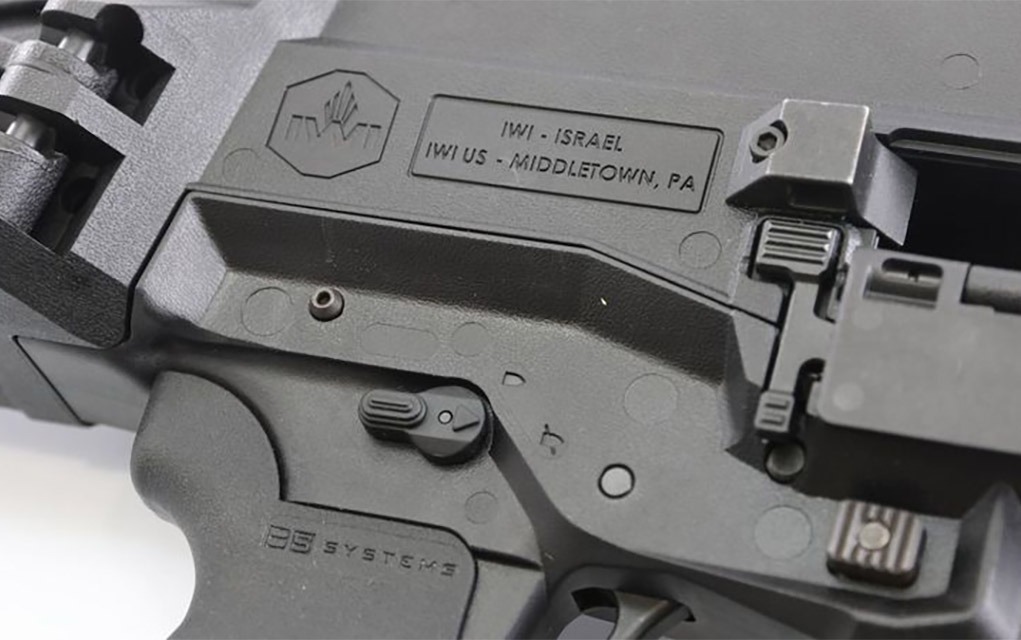

Wait … a bonus feature: You can swap the charging handle from one side to the other. So, everyone ought to rejoice.
The pistol grip is a B5 systems grip—which is not my fave. A lot of people like them, but the receiver at the pistol grip is exactly like that of the AR-15, so you can swap off the IWI Carmel pistol grip and install the one of your choice.
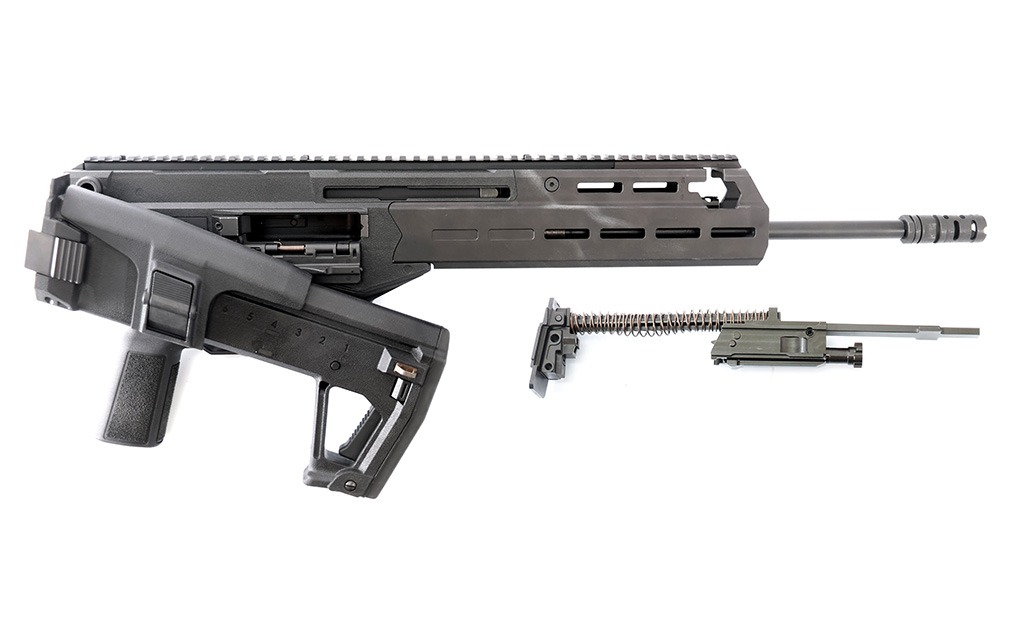

On the back end, the Carmel has a folding stock. And as if that wasn’t enough, the stock also has an adjustable cheekpiece, so you can lift it up or lower it, to get your eye directly behind whatever aiming system you have installed. Also, there is no lack of ways to attach a sling. The M-Lok slots up front, of course, then a set of QD sockets at the upper rear of the receiver, then HK-style loops for a sling clip on the stock itself.


In testing, the good stuff keeps on keeping on. The trigger is excellent, and it’s a two-stage design so it has a clean take-up and a clean break. That’s the good news. The bad news is that the design is not compatible with the AR-15 trigger system, so if you want some other trigger on your Carmel, you can’t have it. Were the Carmel trigger other than excellent this would be a real problem, but it’s more than good enough, so you won’t have to go swapping out fire control systems here.
The ambi controls make running the Carmel easy, regardless of left- or right-handedness, and if you want to swap to fire around a corner, you can easily do so.
The charging handle swap is particularly easy. Lock the bolt back, and then slide the charging handle (it’s non-reciprocating) until it lines up with the clearance notch in the handguard. Then, push the charging handle over to the other side. Reach over and tug on it, to ensure it is fully over, and then slide it all the way forward. Done.
The three-position gas regulator is also accessed by way of a relief cut made to the aluminum handguard. The three settings are regular, extreme and suppressor. I suspect that extreme would be used only in … oh, ah … extreme circumstances, like arctic cold or to keep it running even though you haven’t been able to do any maintenance on it for a week of heavy fighting. Now that’s something the IDF would know about, the rest of us not so much. And the suppressor setting should be obvious.
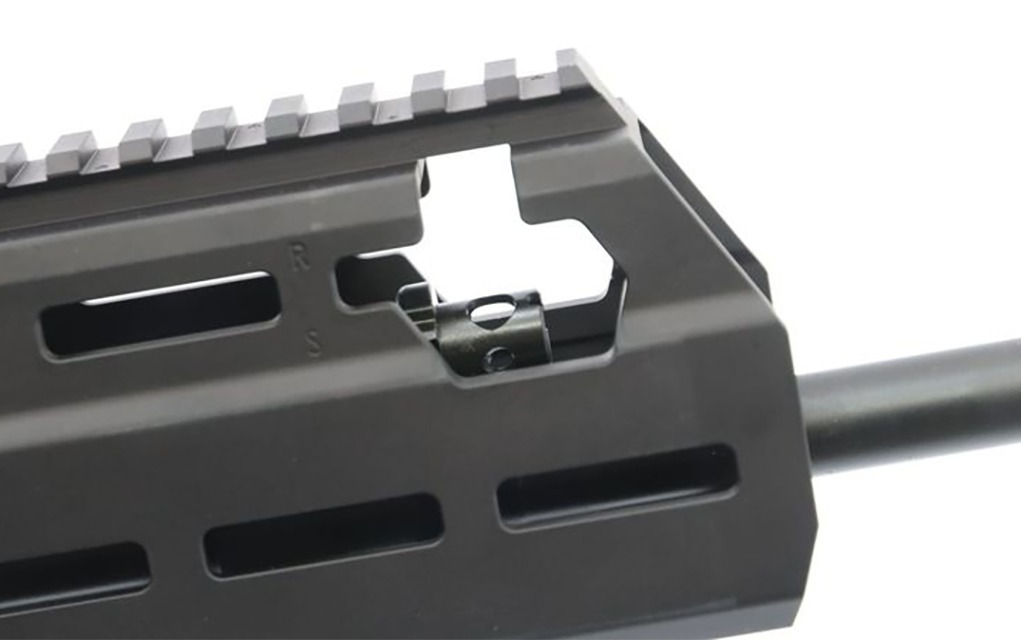

The trigger is very nice, and the ejection is forward, so if you are running the Carmel from your left shoulder you don’t have to worry about brass in the face. I tried a magazine from the left shoulder, just to see if there were any face-gas problems, and there weren’t. I’m happy on that point.
The stock is length-adjustable as well as cheekpiece-height adjustable, and it was easy enough to get it set up to fit me. The stock folds by pressing a button on the left side and hinging the stock around to the right. It’s pitched so it doesn’t block the ejection port when folded.
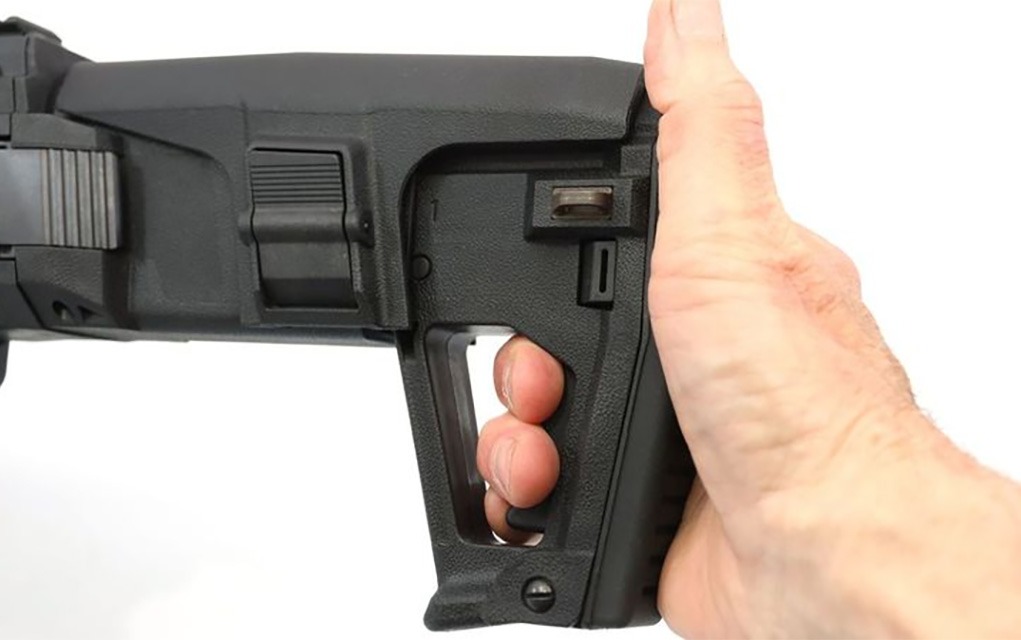

The stock is also the way to disassemble for cleaning. Unload and close the bolt. Hinge the stock folded. In the rear plate that’s uncovered is a button. Lean hard on the button and slide the stock-latch clip out to the left. Now, use the charging handle to pop the action open and also open the rear plate. It all comes out in one piece and is easy to clean. The trigger assembly is simple as well: Press the rear takedown pin (there isn’t a front one) from right to left (it, too, will fight you like crazy), and then hinge the housing down and out.
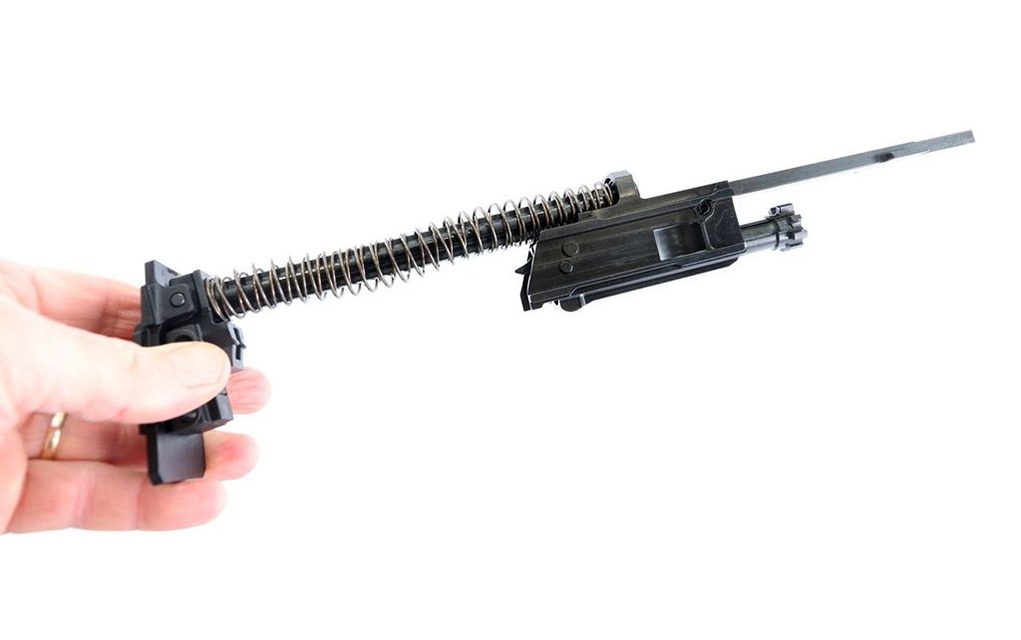

In testing, I put a Leupold scope on top and the Carmel proved to be superbly accurate. The nice trigger and the adjustable stock were parts of that, but IWI clearly knows how to make a good barrel.


Certain Considerations
So, with all these good points, what’s the deal? Why has it proven so hard to warm up to the Carmel? Sigh.
First up is the mode of manufacture. The upper (which is the rifle, that’s where the serial number is) is a polymer/aluminum assemblage. The receiver portion is an aluminum-reinforced polymer shell. The handguard is aluminum. What gets hot fast when you shoot? The barrel, and it radiates it to the handguard. So, the handguard is going to heat up faster than the receiver and make it more difficult to hang onto.


To be fair, it works just like an AR-15, by the way, except the polymer receiver of the Carmel isn’t going to dissipate heat from the bolt—not that it gets much, since it’s a piston system. But a piston system must vent gas someplace, and they do so at … the handguard.
The polymer/aluminum design creates a boxy receiver set. At times, it felt like I was schlepping around a 1980s camcorder. The AR-15 has been undergoing a diet of sorts, becoming slimmer in its outlines, and for the Carmel to not only go backward but back past the blockiest AR-15 ever is something to get used to.
As an example, on the slimmest AR-15 handguards, I can wrap my hand fully around the handguard and have my thumb and fingers touching. A lot of shooters who are taking their cues from the special ops people like to wrap their hand around the handguard with their thumb up on top. That’s not possible with the Carmel. Maybe, if the Carmel catches on enough, some aftermarket maker will come up with a slimmer handguard design.


And then there’s the stock. Now, the adjustments are easy. Grab the stock buttplate with your fingers inside of the triangular loop, squeeze and it’s unlocked. Push or pull to the length you want and let go; it will lock in place at one of the six settings. That’s the good part. The cheekpiece has a hinged lever: press in on both sides, and push or pull the cheekpiece to the height you want and let go. It isn’t ergonomic; it takes force, and there are four settings.
The button to unlock to hinge? Eat your Wheaties, because you have to have it fully depressed to unlock it, and that’s apparently where the spare Buick suspension springs all went. Halfway measures won’t do here. Similarly, when you want to unfold the stock, you have to practically slam it to get it to lock, because the locking tab is a big, beefy chunk of steel that won’t lock without force. And the locking tab is the worst part. The locking tab protrudes up and out of the rear of the receiver when the stock is folded.
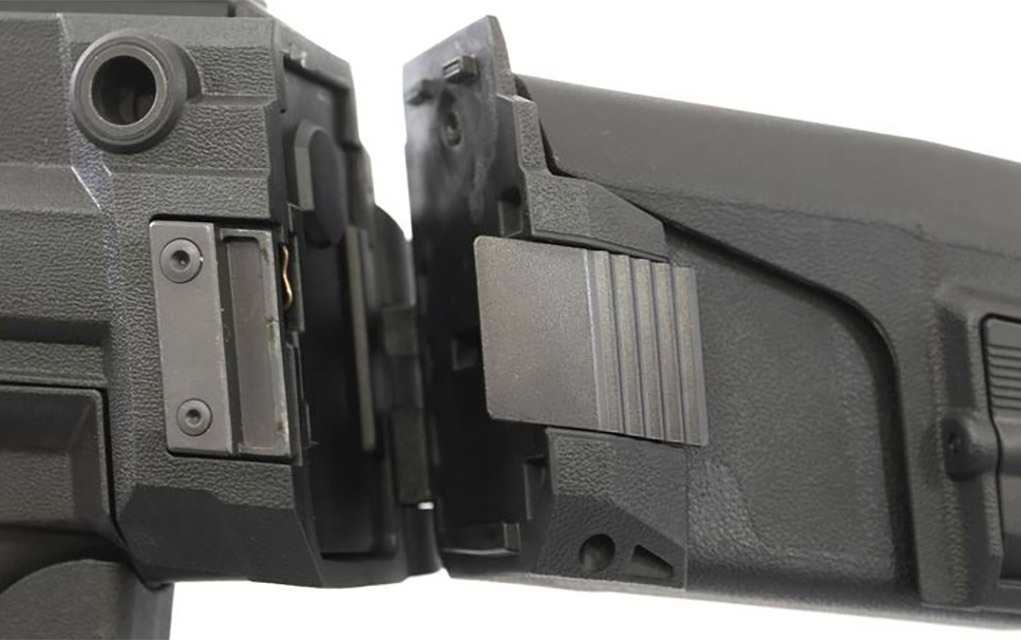

Then, when folded, the stock makes the already portly Carmel into a salesman’s case-sized package, and while it’s not long, it is fat. Admittedly, no folding rifle is skinny when folded, but the Carmel is particularly egregious in this regard.
Lastly, the comp? Well, it does do its job, but the Carmel starts out at a smidge over 8 pounds. By the time I had a scope and loaded magazine on it, it was over 9 pounds. If you were to add a sling and a light, now we’re talking a rifle that easily weighs as much as an M1 Garand. It’s easy to get an AR-15 that starts under 7 pounds, so the Carmel starts more than a pound over.
The price is within the range of a well-built AR-15 these days, but you can easily find an AR for a lot less, rebuild it to be a folder if you wish, and still have money left over for practice ammo.
But remember, as I said in the beginning: This is not an AR. Maybe these items I find to be hindrances don’t bother you a bit. To each his—or her, of course—own. It’s gotta be your call.
IWI Carmel SPECS:
- Type: Semi-auto carbine
- Caliber: 5.56 NATO
- Capacity: 30+1 Rounds (Uses standard AR-15 magazines)
- Barrel: 16 Inches
- Length: 26¾ Inches w/ stock folded, 33¾ Inches w/ stock collapsed, 37¼ Inches w/ stock extended
- Width: 2.6 Inches
- Height: 8.2 Inches
- Weight: 8 Pounds, 3 Ounces
- Trigger: 4 Pounds, 9 Ounces
- Sights: n/a
- Grips: n/a
- Finish: Black oxide, anodizing and polymer
- MSRP: $1,799
- Website: iwi.us
Editor’s Note: This article originally appeared in the June 2024 issue of Gun Digest the Magazine.
More Rifle & Carbine Reviews:


Next Step: Get your FREE Printable Target Pack
Enhance your shooting precision with our 62 MOA Targets, perfect for rifles and handguns. Crafted in collaboration with Storm Tactical for accuracy and versatility.
Subscribe to the Gun Digest email newsletter and get your downloadable target pack sent straight to your inbox. Stay updated with the latest firearms info in the industry.





